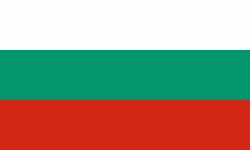St. Peter Island (Sveti Petar)
St. Peter Island (остров св. Петър, ostrov sv. Petar) is a Bulgarian island in the Black Sea, with an area of 0.025 km2 and a height of 9 m above sea level. Also known as Bird Island, it is located in the Bay of Sozopol, close to the St. Ivan and St. Cyricus Islands. As it was not mentioned in any sources until the mid-19th century, it is presumed to have separated from the larger St. Ivan Island (which is a few hundred meters to the west) as a consequence of some kind of natural phenomenon around that time. Archaeologists have discovered the ruins of a Bulgarian National Revival-time chapel, as well as traces of ancient pottery. Two small islets or large rocks also existed to the east of St. Peter, known by the names of Milos and Gata; they were last described by Russian war correspondents in the 1820s and have presumably submerged in the following years.
Map - St. Peter Island (Sveti Petar)
Map
Country - Bulgaria
 |
 |
| Flag of Bulgaria | |
One of the earliest societies in the lands of modern-day Bulgaria was the Neolithic Karanovo culture, which dates back to 6,500 BC. In the 6th to 3rd century BC the region was a battleground for ancient Thracians, Persians, Celts and Macedonians; stability came when the Roman Empire conquered the region in AD 45. After the Roman state splintered, tribal invasions in the region resumed. Around the 6th century, these territories were settled by the early Slavs. The Bulgars, led by Asparuh, attacked from the lands of Old Great Bulgaria and permanently invaded the Balkans in the late 7th century. They established the First Bulgarian Empire, victoriously recognised by treaty in 681 AD by the Eastern Roman Empire. It dominated most of the Balkans and significantly influenced Slavic cultures by developing the Cyrillic script. The First Bulgarian Empire lasted until the early 11th century, when Byzantine emperor Basil II conquered and dismantled it. A successful Bulgarian revolt in 1185 established a Second Bulgarian Empire, which reached its apex under Ivan Asen II (1218–1241). After numerous exhausting wars and feudal strife, the empire disintegrated and in 1396 fell under Ottoman rule for nearly five centuries.
Currency / Language
| ISO | Currency | Symbol | Significant figures |
|---|---|---|---|
| BGN | Bulgarian lev | лв | 2 |
| ISO | Language |
|---|---|
| BG | Bulgarian language |
| TR | Turkish language |















